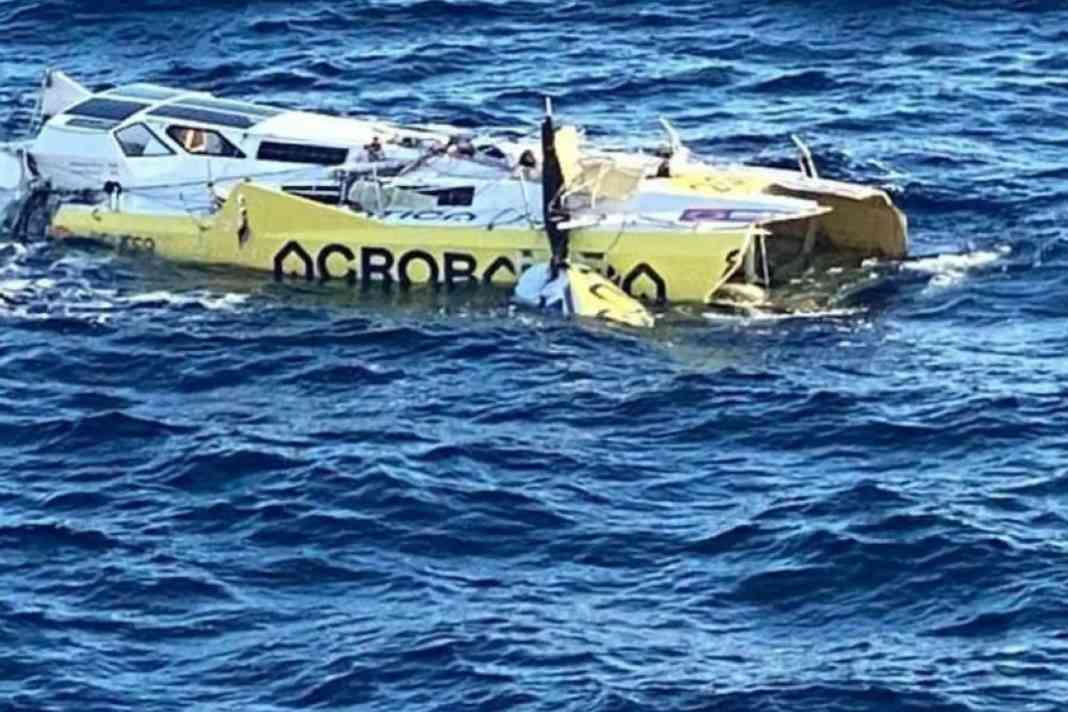"Acrobatica": Accidental Class 40 resurfaced after four months






On 9 July 2024, the "Acrobatica" collided with the tanker "Silver Ray" in heavy seas during the Transat Québec Saint-Malo. The Class 40 was so badly damaged that she was expected to sink quickly. She has now been sighted and photographed 350 nautical miles east of the Azores by the Dutch cargo ship "Ijzerborg".
Original article from 10 July 2024:
A fatal accident overshadowed the 9th day of the Transat Québec Saint-Malo. The Class 40 of Alberto Riva, Jean Marre and Tomaso Stella was wrecked in strong winds and heavy seas. Just a few months ago, the "Acrobatica" had set a new 24-hour record - but now, of all times, it has been broken.
When the crew of the "Acrobatica" sent out a distress call yesterday at 3 pm (CET), the sinking of their yacht already seemed inevitable. The signal from the Sarsat emergency beacon reached their direct rivals Antoine and Olivier Magre, the skippers of the "Leclerc-Ville Legrand". Not only did they immediately inform the race organisers, they also changed course themselves in order to reach the scene of the accident, some 11 nautical miles away.
Within a very short time, they reached it together with their crew member James Murphy. Around 300 nautical miles north of the Azores island of Flores, they could only watch as the crew of the "Acrobatica", who had previously made it to their life raft in good time, were safely taken on board by the Liberian tanker "Silver Star". The unharmed crew are now heading back to America, while the wrecked racing yacht remains behind.
The exact causes of the accident involving the Class 40 "Acrobatica" are still unknown. At the same time, however, she also lost her status as the fastest Class 40 of all time. In the Niji 40 transatlantic race in April this year, the Guelfi design, which was only launched in 2023, had travelled an incredible 433.53 nautical miles within 24 hours. But now, of all times, another Class 40 was even faster and equalled the record.
McGyver repair: rudder blade replacement on the open sea
Frenchman Guillaume Pirouelle and his team sailed an incredible 440.2 nautical miles at an average speed of 18.34 knots. The conditions for this record-breaking race were close to the limit. Competitor Fabien Delahaye reports a hellish night with thunderstorms and gusts of 40 knots. "It's not easy to rest. We are completely soaked," says the skipper of the current leader "Legallais".
There are still around 900 nautical miles to go before the finish line. The Transat Québec Saint-Malo leads from Québec in Canada to Saint-Malo in France. While the field has closed to within 100 nautical miles in the past few hours, other participants have also broken up.
Among other things, the currently second-placed "Amarris" lost its rudder blade. Instead of heading for the Azores and carrying out a repair there, Achille Nebout's team decided to take a riskier route: changing the functioning rudder blade from port to starboard, which is more important on the current course. "That's very risky, because if you drop the second rudder blade into the water, the race is over," says the French skipper. But his team's efforts were rewarded: "After two to three hours of work, we managed to insert the rudder blade."
"The disappointment is huge" - Burke/Fink thwarted by broken forestay
Meanwhile, the German offshore youngsters Lennart Burke and Melwin Fink and their team were unable to set off on the almost 3,000 nautical mile course. An airline had messed up the punctual delivery of the forestay ordered in France, which was supposed to - and had to - replace its predecessor that had broken a few days earlier during training.
Although the new forestay has now reached the young team in Canada, the "Sign for Com" will no longer be involved in racing. Instead, a safe transfer is planned and the new forestay has already passed its first tests. A statement on the junior racing team's Instagram channel reads: "The risk of losing the mast due to the new, untested rig configuration is simply too high. The regatta is too far advanced to justify the risk. The disappointment is huge, this race was supposed to be the highlight of the season and end our Atlantic round."
The last video from on board the "Acrobatica" before the dramatic accident:
At this point, you will find external content that complements the article. You can display and hide it with a click.

